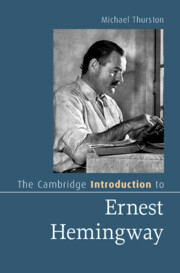
-
Select format
-
- Publisher:
- Cambridge University Press
- Publication date:
- September 2025
- October 2025
- ISBN:
- 9781009422673
- 9781009422710
- 9781009422727
- Dimensions:
- (228 x 152 mm)
- Weight & Pages:
- 0.463kg, 214 Pages
- Dimensions:
- (228 x 152 mm)
- Weight & Pages:
- 0.317kg, 214 Pages
You may already have access via personal or institutional login
Book description
One hundred years after the publication of his first major work, Ernest Hemingway remains an important author. His work addressed the search for meaning in the wake of a 'Great War' and amid the challenges of rapidly changing social conventions, and his prose style has influenced generations of journalists and writers. Hemingway was wounded on the battlefield and caught up throughout his life in conflicting desires. He was also a deeply committed artist, a restless experimenter with the elements of narrative form and prose style. This book's detailed discussions, informed both by close formal analysis and by contemporary critical frameworks, tease out the complexity with which Hemingway depicted disabled characters and romantic relationships in changing historical and cultural contexts. This introduction is especially useful for students and teachers in literary studies and modernism.
Contents
Metrics
Altmetric attention score
Full text views
Full text views help Loading metrics...
Loading metrics...
* Views captured on Cambridge Core between #date#. This data will be updated every 24 hours.
Usage data cannot currently be displayed.
Accessibility standard: WCAG 2.2 AAA
Why this information is here
This section outlines the accessibility features of this content - including support for screen readers, full keyboard navigation and high-contrast display options. This may not be relevant for you.
Accessibility Information
The PDF of this book complies with version 2.2 of the Web Content Accessibility Guidelines (WCAG), offering more comprehensive accessibility measures for a broad range of users and attains the highest (AAA) level of WCAG compliance, optimising the user experience by meeting the most extensive accessibility guidelines.
Content Navigation
Table of contents navigation
Allows you to navigate directly to chapters, sections, or non‐text items through a linked table of contents, reducing the need for extensive scrolling.
Index navigation
Provides an interactive index, letting you go straight to where a term or subject appears in the text without manual searching.
Reading Order and Textual Equivalents
Single logical reading order
You will encounter all content (including footnotes, captions, etc.) in a clear, sequential flow, making it easier to follow with assistive tools like screen readers.
Visual Accessibility
Use of colour is not sole means of conveying information
You will still understand key ideas or prompts without relying solely on colour, which is especially helpful if you have colour vision deficiencies.
Use of high contrast between text and background colour
You benefit from high‐contrast text, which improves legibility if you have low vision or if you are reading in less‐than‐ideal lighting conditions.

